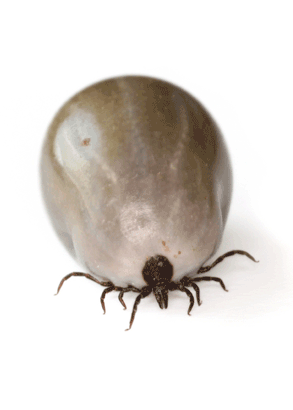

With summer just around the corner, and a rise in the number of Lyme disease-infected ticks confirmed in the province, WorkSafeNB wants workers to protect themselves before they head into the bush.
Lyme disease is a bacterial illness caused by the bite of infected deer ticks, named after the town of Lyme, Connecticut, where it was first identified in 1975. Infected ticks thrive in and around temperate grassy and wooded environments and latch onto host species when they brush up against them. Tick bites are usually painless and many people never even know they’ve been bit.
It’s a lesson that Hampton town councillor Robert Doucet learned the hard way. In 2002, he was employed as an engineering technician, spending a lot of time surveying in the woods. Near the end of that year, he began feeling general malaise. His symptoms continued for years until he was finally diagnosed with the disease in 2006. By then, the damage was done.
“I’ve got chronic pain in my joints and cognitive problems as well. Multi-tasking can be very difficult,” he said. “Not knowing was my biggest problem. Had I known what I know now, something could have been done.”
So today, Doucet does what he can. A board member with the Canadian Lyme Disease Foundation (CanLyme), he finds himself interacting with the public to get the word out, just as he did May 1 when he presented the “Tick Talk” at the Hampton Middle School.

“We aren’t seeing a great deal of concern from the government at any level so we need to take it upon ourselves to raise awareness.”
The risk is likely higher in areas of known endemic tick populations in the Millidgeville area of Saint John and Grand Manan Island, where more than 20% of tick samples are confirmed to have the disease. In 2012, tests from the Tantramar region revealed that 40% of ticks were infected. Doucet said there is no reason to believe it will stay confined to those regions.
“They’re called deer ticks but they also attach themselves to migratory birds that cross borders all the time. It’s foolish to assume that if it’s a problem in New Hampshire, it’s not a problem here.”
Lyme disease is easily treatable with antibiotics when diagnosed early. However, if treatment is delayed, as in Doucet’s case, generalized Lyme disease and serious complications can result in nerve damage and heart palpitations, a point he can’t emphasize enough.
“Caught early, you take a prescription for a month or two and you’re on your way. I’ll go to my grave with this disease so until then, my mission is to put the spotlight on the issue. I don’t want to see anyone lose their quality of life the way I have.”
Recommended preventative action
People who work in tall grass, brush or forested areas – anglers, farmers, loggers, trappers, biologists, to name a few – should take extra precautions during the summer months:
If you discover you’ve been bit, it is important to remove the tick properly:
For more information on Lyme disease, consult the following resources:
CanLyme – Canadian Lyme Disease Foundation
Office of the Chief Medical Officer of Health (Public Health)
Public Health Agency of Canada – Lyme Disease Fact Sheet